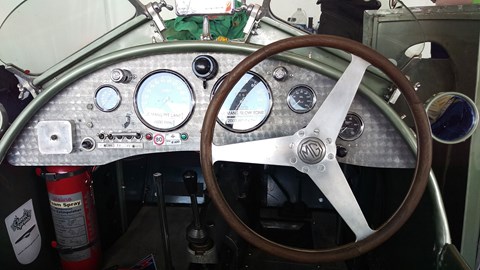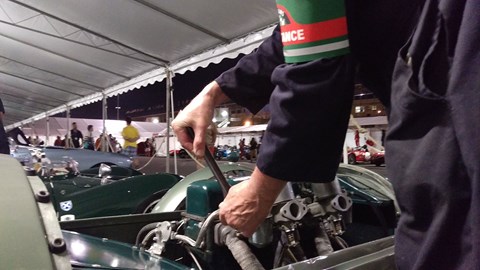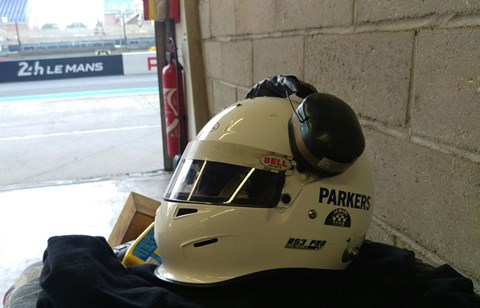► Join us racing at the Le Mans Classic
► A driver’s blog from world’s biggest classic race
► We race an MG TC – with 1.5 litres!
When I made the difficult decision to part company with my single-seat race car two-and-a-half years ago, little did I know it would begin a chain of events that would culminate with me hammering down the iconic Mulsanne straight at 100mph at 3am – surrounded by a group of professional drivers in priceless competition cars jockeying for position.
The chap I sold my car to – Simon – had a plan. He wanted to race at the world’s biggest old car event: the Le Mans Classic. This is a collection of around 500 of the greatest racing machines ever built. Everything from pre-war Bugatti Type 35s to fire-spitting Group C monsters like the Porsche 917 compete against other cars from the same period in a trio of races. One of which is held at night…
Taking on Le Mans Classic in a tiny MG TC
Our car was an MG TC called the George Phillips Le Mans special, rebuilt from the ground up by renowned specialist Phil Cornut to comply with FIA regulations for the Historic Technical Passport, a must if you want to do the Classic. As you can see from the pictures, it’s an open car, and it does without almost any safety gear at all. There aren’t even any seatbelts.

The TC is a derivation of the pre-war TB, so its design is significantly older than most of the other machines in our 1949-1956 grid. Up against a brace of Jaguar D-Types, Mercedes 300SLs and Aston Martin DB2s driven by handy wheelmen like Le Mans 24 Hour winner Andy Wallace and BTCC ace Sam Tordoff, it’s fair to say we were never going to win outright in our 1250cc MG, but there were some slower cars on the 73-strong grid that looked much closer to our performance.
Incidentally, we’d be the first TC to race on the Circuit de la Sarthe since 1950 – a nice little fact that had the whole historic MG community following our progress closely.
‘I learned the Le Mans track on Gran Turismo’
The first qualifying session went without a hitch once we’d got over the nerves. We needed to learn the track first – it’s all very well watching videos and playing computer games, but nothing can prepare you for actually getting out there and driving the 8.47-mile Le Mans lap yourself.
I’ll be the first to admit it was totally different to the console game I’d used to learn which way the corners go, mainly because of the elevation changes and cambers that create challenges that just weren’t there on the big screen.

Night qualifying didn’t go quite so well. Owner Simon went out first and put in a few solid laps, but on my out-lap the car developed a problem. At first I noticed a misfire under load coming out of some corners, so I slowed down a little and decided to pit. Then I smelled the unmistakably chemical stench of race fuel, which seemed to get stronger and stronger the slower I went… Something wasn’t right, but I was almost at the pits so I nursed it in.
Not having a flaming good time
As I pulled to a stop a number of things became clear: first, I was drenched in petrol. My helmet and race suit were sodden with the intoxicating stuff. Second, I could see it dripping out of the engine vent in front of me, right where the inch-and-a-half side-draught carbs were. I quickly shut off the car’s ignition and stopped the fuel flow, jumped out and saw a large puddle under the car. Clearly a massive fuel leak had occurred, but then the smoking started.
Highly combustible 102 RON fluid had found its way onto the exhaust manifold, which thankfully was covered in heatwrap but was getting extremely close to igniting. We grabbed an extinguisher from the pits and waited… would the car survive the night?

It was our lucky day. The car made it. Once it had cooled down enough to investigate the cause of the leak it became clear that one of the fuel bulbs had shaken loose and started dumping fuel out of the side of the engine. It only needed tightening up. The joys of historic motor racing!
By the time we’d finished cleaning the car and my clothing up it was 2am and time for bed.
Wake up! Time to go racing…
Race day arrived and everyone was on edge. Would the car throw another spanner in the works? Could anything else go wrong? The first 43-minute session was 5:40pm on Saturday and it was extremely warm, with one thermometer reading 39 degrees centigrade. If anything was going to defeat the plucky MG, surely this was when it would happen.
But actually it went well. We managed the whole race including our driver change without hiccup, Simon taking the false Le Mans start – where drivers start on one side of the track, run to their car on the other, fire it up and race off – and the rolling start for the real race easily in his stride.
I did the second stint and saw the chequered flag after the race was red-flagged following a serious accident. The drivers don’t hold back in this sort of racing, despite the sheer eye-watering value of the cars involved.

Collecting the results sheet we were in for a surprise: not only had we finished, but our little 108bhp car had come in 33rd overall. Astonishing.
We had some waiting to do then, with the sun finally going down at around 10pm making way for the uniquely electric atmosphere that is Le Mans at night.
Barrelling down the Mulsanne straight at night
Our next race was due to start at 2:05am early on the Sunday morning, but due to another incident in the race beforehand it was running a few minutes late. Since I’d not even completed a whole lap of the course at night, I was a little more apprehensive about this one. We decided to stick to the original plan and have Simon start the race – I’d hop in after his stint and hopefully bring the car home in one piece.

Slightly distracted by a chap driving far too slowly down the pit lane, I got the car out on track and drove with more concentration than ever before. Racing at night is a totally different ball game. I’d driven on track in the dark before, but that was totally floodlit.
At Le Mans there are stretches – including some challenging high-speed corners – that are completely dark. It takes your brain a while to adjust to this, especially since the headlights in our MG were about as effective as gluing a pair of candles to the front bumper.
Still, once again we saw that black-and-white flag waved and we finished the race, this time placing 35th overall. Seems our first result wasn’t just a one-off…
Can’t sleep, won’t sleep
The final race was due to start at 10.10am on Sunday but rest wasn’t an option. The paddock is alive for the duration, and any thoughts of a brief period of shut-eye was put firmly out of the question when I heard the mental Group C sports cars fire up in the early hours.
As the final race approached there was a relaxed feeling in the paddock. People were chatting to one another, helping out and generally there was a sense that it would soon all be over. We went to fire up the engine to get some heat into it, operating the fuel toggle and clicking the ignition switches down before pressing the starter button and… nothing. The car was dead.

After a bit of investigation it turned out to be as simple as a loose wire on the distributor. We borrowed a crimping tool from the team next door and fixed it, then Simon drove the car out to start the last race of our weekend.
Did you make it to the end?
Simon’s first laps were consistent and uneventful, though he did mention the car was popping and banging more than usual on the overrun. I went out and began to see what he meant. The exhaust was a new straight-through pipe to replace the over-silenced one from before, and we were still learning about the effects it had on the car.

I carried on regardless, driving quickly but not pushing the car overly hard, until on what would have been the final lap I saw something to make any historic racer’s blood run cold: the oil temperature needle swung rapidly around to maximum. I wasn’t happy about this, so backed right off. The needle simply wouldn’t come down again no matter what I did, so while the oil pressure and water temperature needles were pegged exactly where they should be, I decided it wasn’t worth continuing and pulled into the pits. You don’t mess around with oil in old cars. We retired the TC rather than risk a scuppered motor.
After a period of disappointment at finishing the weekend in such a way, we learned that we had one saving grace. The regulations stated that since we’d covered the majority of laps, we’d still classify and our results would count, albeit with a penalty of 57 minutes for not finishing the final stint. With everything else that happened to other people during the weekend and our results in the first two races, we actually ended up in 37th position overall out of 73 entrants.
We were over the moon. Frankly we’d expected to make up the numbers, not place half way up a grid of far more advanced, powerful and expensive machinery. We didn’t make the podium, but we put up a good fight. The champagne tasted great that evening.
MG TC George Phillips Le Mans Special – 1947
- Layout: Two-seat open sports car
- Engine: 1250cc OHV in-line four cylinder, race tuned, inch-and-a-half twin-SU carburettors, polished and ported head
- Power: 108bhp @ 5800rpm
- Transmission: Four-speed manual, rear-wheel drive, 4.2:1 open differential
- Brakes: Lockheed hydraulic drum brakes all round
- Suspension: Half-elliptic leaf springs controlled by Leda hydraulic shocks front and rear, three-quarter floating rear axle
- Steering: Worm and peg, fixed aluminium wheel finished in wood
- Weight: 600kg
- Top speed: 100mph
- 0-62mph: 5.5 seconds (owner measurement)
- Fuel consumption: 10mpg approx
Photos by: Colin Murrell of MGCC
